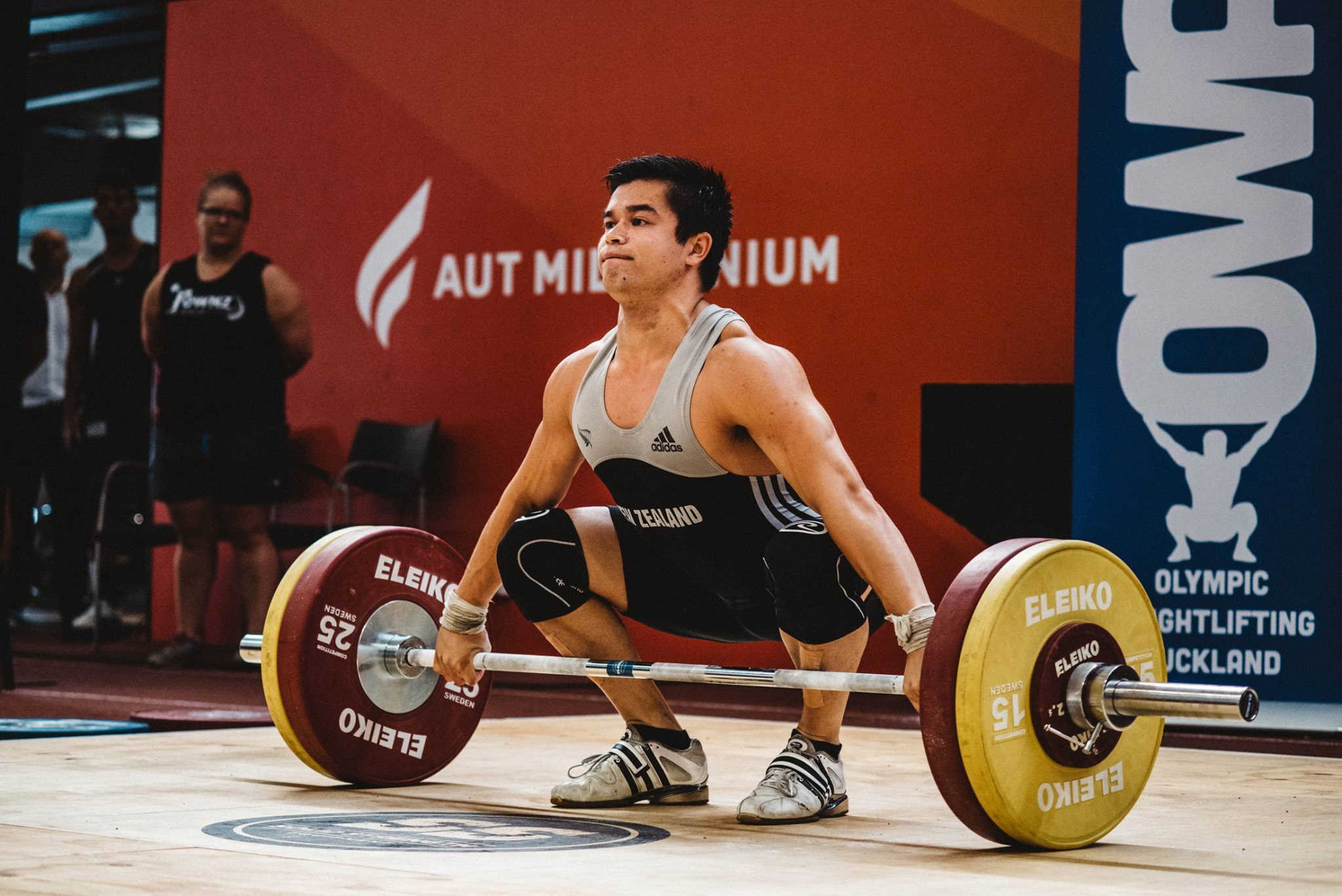What is Weightlifting?
Weightlifting is a sport that provides opportunities for athletes to compete at all levels from local to International. Weightlifting is an Olympic Games and Commonwealth Games sport in which athletes perform two lifts – the Snatch and the Clean & Jerk. Weightlifting training develops strength, speed, power, flexibility, coordination and Balance.
Weightlifters compete within bodyweight categories and often also within age groups. There are seven bodyweight categories for women, ranging from less than 48kg, up to Over 75kg. For men, there are eight categories with the lightest being under 56kg; and the heaviest, Over 105kg.
Auckland Championships and NZ National Championships are held in age groups of Under 15; Under 17 (Youth); Under 20 (Junior); Senior (Open); and Masters (35 and over). In addition to championships events, Auckland weightlifting clubs conduct regular club events.
Is it Safe?
With correct coaching, proper equipment, and realistic expectations, weightlifting training is safe and beneficial for most people. Unfortunately there are still some myths which cause concern to those who haven’t experienced weightlifting training first-hand.
Many years ago it was recommended that children and adolescents should avoid weightlifting, because it was thought to expose them to a greater risk of musculoskeletal injuries. But a retrospective review of the effects of weightlifting on preadolescents and adolescents found that weightlifting posed no extraordinary risk to healthy growth and in fact contributed to greater bone density and stronger joints.
A properly designed and supervised weightlifting training program can provide a safe and effective way to obtain the following benefits:
- Improved muscle tone
- Improved joint flexibility
- Better motor skills
- Increased strength, power & speed
- Improved body composition
- Better cardio respiratory function
- Improved overall sports performance
- Greater confidence and self esteem
How Much? How Soon?
Physical development is related to age, body type, current levels of physical activity and various phases of growth.
To perform the complex movements involved in weightlifting, novices must first learn the basic techniques. As they master the introductory exercises using relatively light weights, they can progressively increase those weights and move on to more advanced training. A qualified coach can monitor the rate of each individual’s progress and greatly assist in the development of advanced skills and the attainment of greater results.
Weightlifters train to develop and perfect their technical skills while at the same time, they are conditioning their bodies to be strong and powerful. This process of learning weightlifting technique, coupled with progressive physical conditioning, provides a balanced approach to overall physical development.
So, the answer to this question is that it depends upon a number of factors. But with good coaching and regular training, most people can expect to see results within a few months of commencement.
Lifting Weights is not all Weightlifting
Understanding the difference between Olympic Weightlifting, strength training, power lifting and body building is important.
Strength Training:
Uses resistance methods to increase a person’s ability to exert or resist force. Free weights, the individual’s own body weight, machines, or other devices (e.g. elastic bands, medicine balls) provide resistance. Strength training is used as an adjunct to many sports and for general physical conditioning.
Powerlifting:
Is a competitive sport in which athletes demonstrate maximum lifting ability. Powerlifting competitions consist of three lifts – the Squat, the Bench Press, and the Dead Lift. Powerlifting training promotes the development of strength.
Bodybuilding:
Is an aesthetic sport that depends on weight training but does not involve lifting in competitions. Bodybuilders use a variety of apparatus to develop large muscles, often isolating individual muscles, or small groups of muscles, with specific exercises. Bodybuilding training promotes the development of muscle size and shape, and body symmetry.
Weightlifting:
Weightlifting is an Olympic Games and Commonwealth Games sport in which athletes perform two lifts – the Snatch and the Clean & Jerk. This is weightlifting
Where is Weightlifting – how do I get involved?
Contact the Olympic Weightlifting Auckland
Weightlifting is a sport which provides opportunities for athletes to compete at all levels from local to International. Weightlifting is an Olympic Games and Commonwealth Games sport in which athletes perform two lifts – the Snatch and the Clean & Jerk. Weightlifting training develops strength, speed, power, flexibility, coordination and Balance.
Is it Safe for Children?
With correct coaching, proper equipment, and realistic expectations, strength training and weightlifting programs designed for children and adolescents are safe and beneficial. Unfortunately there are still many myths which cause concern for parents about the safety of children training with weights for both competitive sport and general fitness purposes. Parents with these concerns can be reassured that strength training and weightlifting can help improve children’s overall health, physical development and sense of psychosocial well-being. A properly designed and supervised strength training and weightlifting program can provide a safe and effective way for children to obtain the following benefits:
- Improved muscle tone
- Improved joint flexibility
- Better motor skills
- Increased strength, power & speed
- Improved body composition
- Better cardio respiratory function
- Improved overall sports performance
- Greater confidence and self esteem
How Much? How Soon?
The development of muscle in children is related to age, body size, previous levels of physical activity and various phases of growth. Many years ago it was recommended that children and adolescents should avoid weightlifting, because it was thought to expose them to a greater risk of musculoskeletal injuries. But a retrospective review of injuries associated with weightlifting in preadolescents and adolescents found that weightlifting is safer than many other sports.
To perform the complex multi joint movements involved in weightlifting, children must first undergo a phase of gradual learning. Beginners must successfully master the introductory exercise techniques using very light weights and only increase those weights under strict, qualified coaching supervision and according to the rate of their skill development. It’s this gradual process of learning weightlifting technique and progressive conditioning that protects children from “overdoing it”.
Where is Weightlifting – how do I get involved?
Contact Olympic Weightlifting Auckland
It is arguably the most spectacular of all Olympic and Commonwealth Games sports in which athletes perform two lifts – the Snatch and the Clean & Jerk. It is an exciting and healthy sport enjoyed by both men and women of all ages (from 12 & up) and of different shapes and sizes. Although commonly seen as a test of strength, Weightlifting is a sport that relies heavily on correct technique, concentration, speed and flexibility in its participants.
Could you be a future Olympian?
Would you like to compete for your Country, your Region or your club?
The sport of Weightlifting has much to offer female participants. Weightlifting builds healthy bodies with strong bones, flexible joints, and good co-ordination. More women and girls are getting involved for health, fitness and as a cross training activity, with participants also enjoying the social interaction provided by weightlifting as a sport.
Parents ask: “Is Weightlifting Safe for Girls?”
With correct coaching, proper equipment, and realistic expectations, strength training and weightlifting programs designed for young girls and adolescents are safe and beneficial. Unfortunately there are still many myths which cause concern for parents about their daughters training with weights for both competitive sport and general fitness purposes.
Parents with these concerns can be reassured that strength training and weightlifting can help improve a child’s overall health, physical development and sense of psychosocial well-being. A properly designed and supervised strength training and weightlifting program can provide a safe and effective way for girls and women to obtain the following benefits:
- Improved muscle tone
- Improved joint flexibility
- Better motor skills
- Increased strength, power & speed
- Improved body composition
- Better cardio respiratory function
- Improved overall sports performance
- Greater confidence and self esteem
In the past, women of all ages have met social barriers created by old-fashioned ideas and confusion about weight training activities, which have prevented them from freely participating in weight training.
Weightlifting does not necessarily mean struggling with huge weights and developing large muscles, as many girls fear. Modern research has shown that lifting weights regularly can improve your general wellbeing and increase your strength and stamina in daily life. If you want to tone up and maintain a healthy weight, Weightlifting training is an effective way to stimulate your metabolism, therefore liberating more energy from the food you eat.
A physically active lifestyle including weightlifting, along with good nutrition, will also help protect you against heart disease, obesity, diabetes and osteoporosis. In the following paragraphs, some common myths are confronted by the truth.
Facts about Weightlifting and Girls
All weight-training sports are not the same.
Due to the low level of publicity surrounding weight training sports, public confusion has arisen about what each sport is about. Body Building is about the aesthetic appearance and size of the muscles, competitive Olympic weightlifting is about using 2 specific techniques relying on the legs (the Snatch and the Clean & Jerk) to lift a weight overhead; and Power lifting uses 3 different lifts relying on the strength of the back, legs and upper body.
Girls can succeed in Weightlifting.
Although Olympic Weightlifting is commonly seen as a test of strength, it is actually a very technically demanding sport. Coaches spend many months teaching a new participant correct lifting techniques and ensuring that these techniques are maintained. Strength can be developed through specific training once Olympic Weightlifting movements are mastered. Women can develop greater strength just as quickly as their male counterparts, so feeling “not strong enough” is even more of a reason to take up weight training.
Weightlifting will not give girls bulky muscles.
Due to the hormonal differences between men and women, females can develop strength through resistance training, without an excessive increase in muscle size or bulk (less than 5mm). Most women participating in Olympic Weightlifting actually experience a loss of excess body fat and therefore experience a reduction in their overall body size.
Weightlifting will not hurt your back.
Olympic Weightlifting techniques are safe and efficient relying on the muscles in the legs and bottom for generating force, with the load shifted away from the spine. Weightlifting training also includes strength and stability training for the abdominal and back muscles.
Weightlifting is a good sport for girls.
There are no biological differences that inhibit women and girl’s capacity to participate in Weightlifting and weight training. In fact due to a female’s tendency to be more flexible than their male counterparts, women are generally able to perform the Weightlifting movements more effectively. Further, a woman’s body can manage a resistance training program just as well as a man’s can.
Weightlifting will not make women infertile:
A Woman’s reproductive organs are internal and therefore protected from the risk of injury through Weightlifting participation. Physically active women normally have easier pregnancies and deliver healthier babies.
Weightlifting will not make female participants overly aggressive or unfeminine.
All sports develop competitive qualities in participants (male or female), however these characteristics, combined with a women’s natural femininity, are exhibited as a heightened level of self-confidence..
Where is Weightlifting – how do I get involved?
Contact Olympic Weightlifting Auckland






